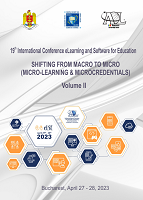THE SYSTEMS THEORY CONCEPT OF REACHABILITY IN AN E-LEARNING MODEL
THE SYSTEMS THEORY CONCEPT OF REACHABILITY IN AN E-LEARNING MODEL
Author(s): Brandusa RaileanuSubject(s): Education, Sociology of Education, Distance learning / e-learning
Published by: Carol I National Defence University Publishing House
Keywords: e-learning; systems theory e-learning model; state-space representation; reachability: Control Systems Toolbox; linear discrete-time systems;
Summary/Abstract: The paper analyses the possibilities of using the systems theory to create learning and elearning models, in order to improve the understanding of the educational process, its organization and efficiency. Three main trends are presented and compared, namely the holistic von Bertalanffy’s general systems theory (GST), the dynamical systems theory (DST), founded by Henry Poincaré and the linear systems theory (LST) in the lines of Rudolf Kalman. This paper belongs to the LST trend and focusses on an e-learning model provided by the author in a previous paper. The basic data of the linear systems e-learning model are the inputs, defined as the amount of knowledge provided by the different types of e-learning methods (such as e-courses, media means, virtual classrooms, web-based training, mobile learning, wiki etc), the outputs represented by the results of various kinds of examinations (tests, final exams, homework etc) and the states, which correspond to the amount of the skills acquired during the e-learning process. The state-space representation of the e-learning process is derived and the model results as a linear, discrete-time, time-invariant control system. The advantage of this approach is that it is based on concrete variables and equations such that one can apply the theory, concepts, and techniques of the linear control systems to study and improve the learning process and the behavior of learners. This paper is devoted to one of the fundamental concepts of the systems theory, the concept of reachability. A reachability Gramian is associated to the system, and it is used to check the complete reachability of the model. A control which ensures a prescribed final state is provided. This model and the developed theory are applied to the foreign languages e-learning process, in which the state variables are defined by considering the four macro language skills acquired in an interval of time. One uses the commands of the Control Systems Toolbox from the software MATLAB and one develops a program which computes the reachability Gramian of the model, verifies if the system is completely reachable and determines the suitable control to reach a desired level of the students’ knowledge.
Journal: Conference proceedings of »eLearning and Software for Education« (eLSE)
- Issue Year: 19/2023
- Issue No: 02
- Page Range: 88-101
- Page Count: 14
- Language: English

